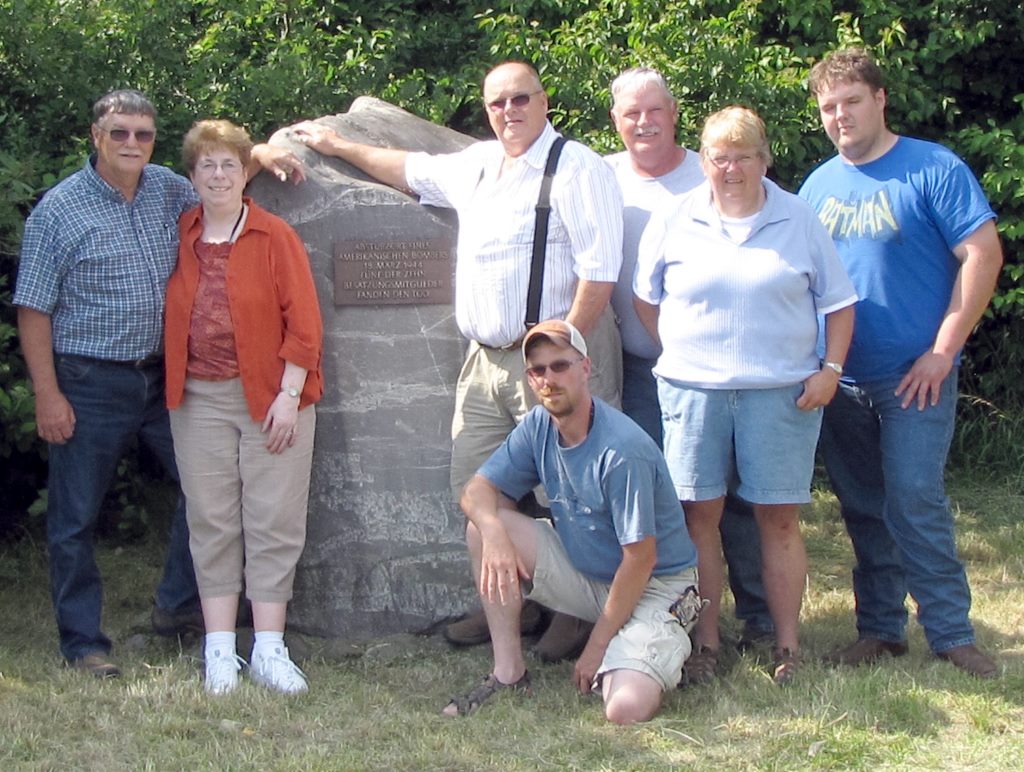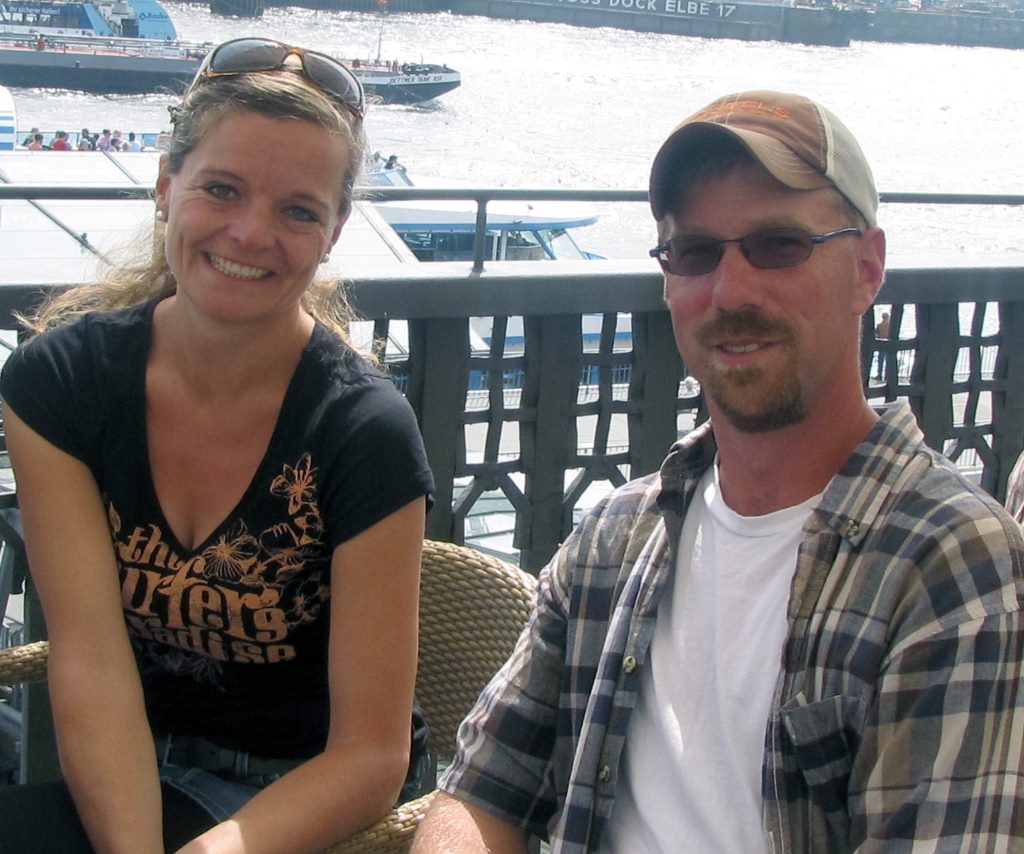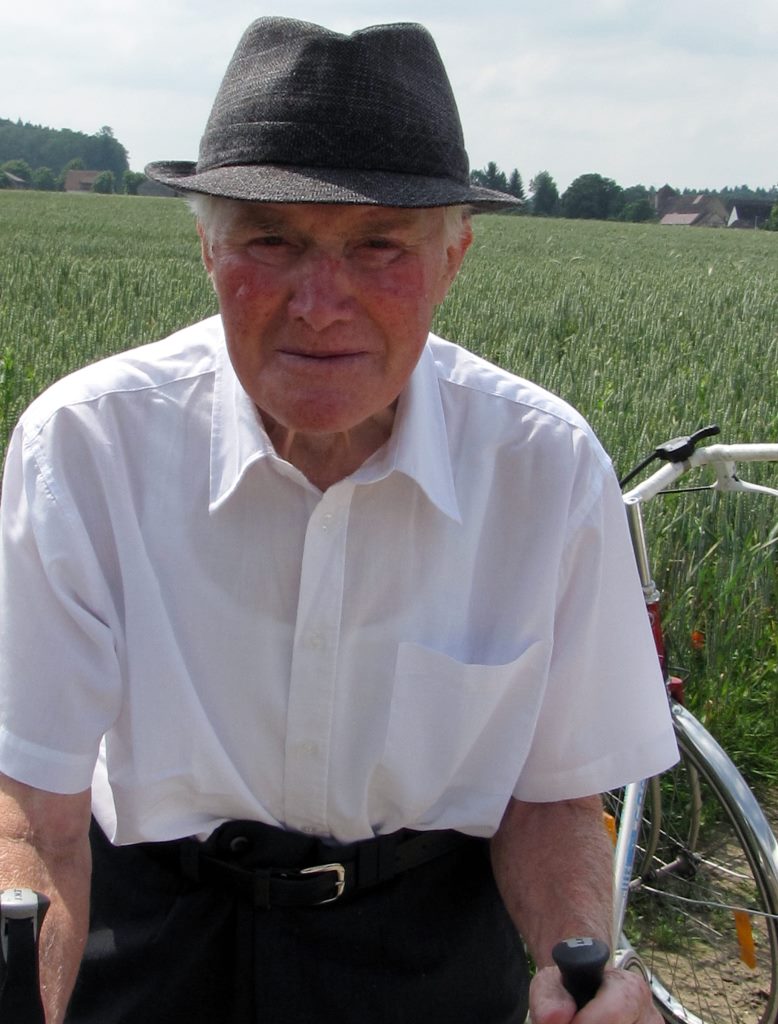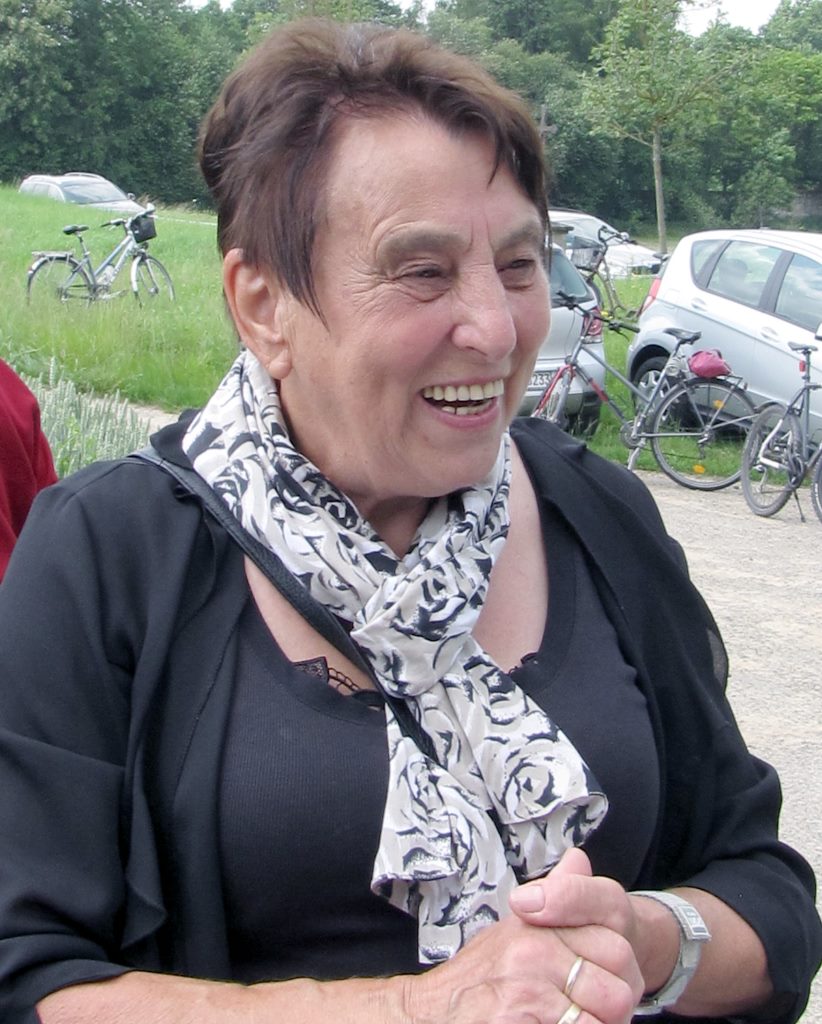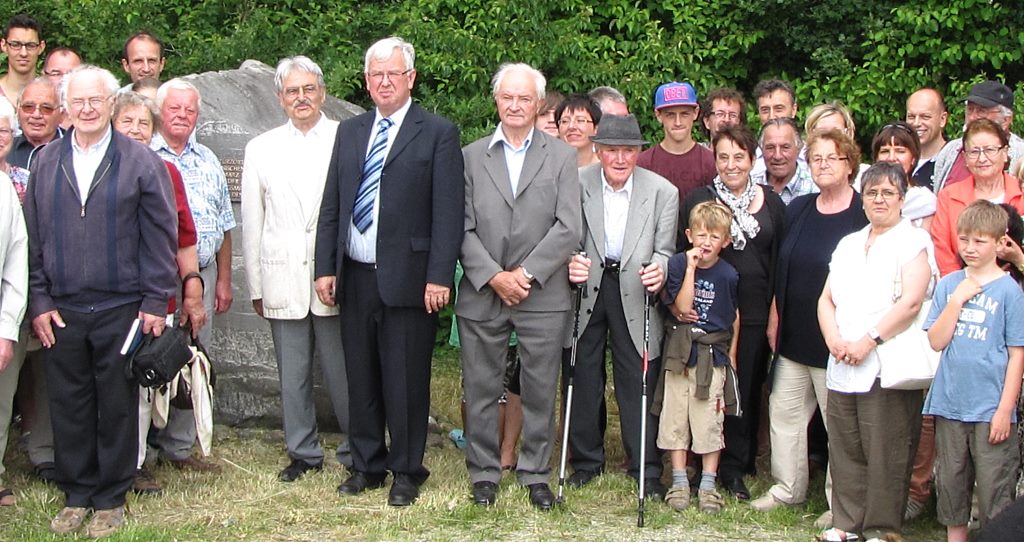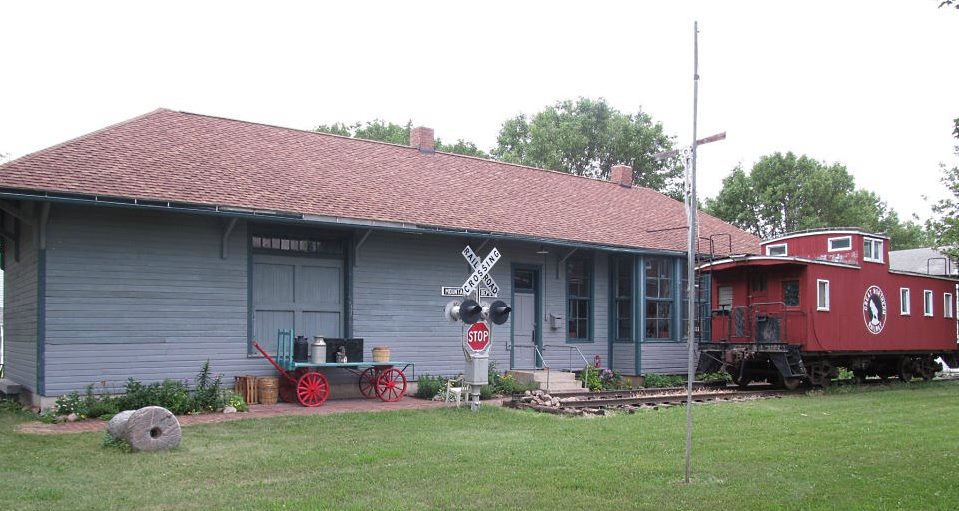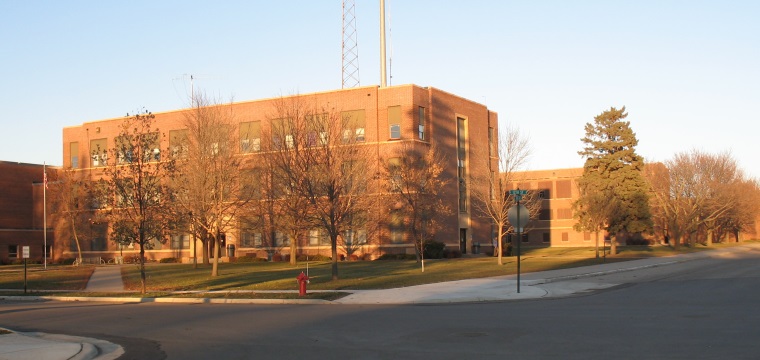A closer look at their ‘Uncle Bob’ Swenson- a man they knew only through photographs and stories

This Monday, May 26 – with people gathering in solemnity in city parks, school auditoriums, civic centers and cemeteries all across the United States – the fallen of this nation will be remembered. Ceremonies will be held in both Mountain Lake and Butterfield honoring those who gave of the ultimate sacrifice in defense of this country.
Not quite a year ago, a trio of “Peterson” brothers, wives and a couple of their family members from around the area employed a “twist” on traditional Memorial Day celebrations – they brought the ceremony of remembrance to where their family member was killed in the line of duty during World War II – Andelfingen, Germany.
The B-17 bomber was not nicknamed “The Flying Fortress” on a whim. It was like a flying tank in the air. A baby-faced 23-year-old from Minnesota, Robert “Bob” Swenson, served as co-pilot on “My Gal,” making bombing runs for the United States Army Air Force over enemy targets, including over the Schwaben Mountains of southwest Germany, where Andelfingen is located. One night, his plane, along with three others, did not return – and Bob would die a young man.
For his family back home, including the songs of his sister and their families, he would only be a man known to them through photographs and stories.
Bob’s sister, Shirley (Swenson) Peterson, had shared the story of her brother with her children. What began as just curiosity about “Uncle Bob” segued into a family trip to remember.
Bob’s nephew and Shirley’s son, Tom Peterson of rural Trimont, his inquisitiveness piqued by this uncle he never knew, began digging into research on the details of the plane crash. That date was March 18, 1944.
Three years ago, in 2011, as Tom was sifting through about 20 pages of unrelated information – one article grabbed his attention – and would not let go. That article was about German author, Herr Otmar Gotterbarm, who had written a book in 2003 about the plane crash – “Als die Feinde vom Himmel fielen” (“When the Enemies Fell from the Sky”). It had taken place near his home when he was two-and-one-half-years-old. For the book, Gotterbarm had interviewed the pilot of the B-17, Ray Neuberg, who had survived the crash.
Neuberg, unfortunately, had passed away, so Tom, his wife Joyce and son Dan started on a quest to instead find the author of the book in order to glean any information he might have on “Uncle Bob.
While a student at Martin County West Public High School, Dan had as a member of his class, a foreign exchange student from Germany, Annika Ott. Social media connections available on Facebook played a major role in tracking down Annika, who now lives in Bremen, Germany.
The detective work was then turned over Annnika, who was able to locate an address, phone number and e-mail for Gotterbarm, and forward that information on to the Petersons. Tom jumped at the opportunity and wrote to Herr Gotterbarm, telling him of of the family’s connection to the plane crash, asking if there was any further history of that incident – and if they could get a copy of his book.
“Otmar,’ Tom explained, “responded with a wonderful letter detailing a multitude of facts about the mission, the events of the day and Bob’s fate. However, he had no more books. They were sold out.”
So, Annika was called into action one more time. She sent out a request via the Internet – and received back – ONE – yes, only one response. There was a book stocked on a shelf in a bookstore in Germany. Annika quickly snatched up that copy – and quickly had it on its way to the Petersons.
The book, however, was, of course – in German. Fortunately the Petersons were able to get it translated by a German friend in the United States. After poring through the English translation, Tom replied back to Gotterbarm – and a two-year back-and-forth correspondence ensued. Soon, the author was more than a distant writer across the Atlantic Ocean in a foreign country – he was a family friend. According to Tom, “Otmar kept saying, ‘You have to come. You have to come.'”
By 2012, Tom, Joyce, and Dan had decided a visit to Andelfingen was really going to happen, and the plan was laid to visit Andelfingen, as well as Heiligkreuztal, Germany, where Gotterbarm now lived. The news of the impending visit broke at a family gathering, and soon, Tom’s older brother, Dick, along with younger brother, Rakki, along with his wife Diane, and their son Leif, all of rural Butterfield, were going along too.
Knotting the family ties
On July 6, 2013, the seven Petersons were headed to Germany, and a meeting up with Botterbarm in Heiligkreuztal. Gotterbarm took the group to the site of the crash, and was also able to show them where all the crew members – including “Uncle Bob” – had landed. Gotterbarm quietly explained that Bob’s body at the time had been taken to a small cemetery chapel near Heiligkreuztal by some local people.
That site was next up on the tour.
Following a pastoral pause at the chapel, the group visited a Memorial Stone, erected in 2003, which commemorates the crash site and honoring the American soldiers who died.
The crash site visit led directly to the small community Andelfingen, which is next to Heiligkreuztal. The five soldiers who died had been taken to Andelfingen and buried in a grave behind the church. (Ironically, as the plane exploded mid-air, one of the engines had flown into Andelfingen and knocked the eaves troughs off the side of the very church in which whose cemetery the five were later buried. The remaining of the parts of the plane landed in various locations in nearby fields. Gotterbarm revealed to the Petersons that the pilot of the B-17 had told him that Bob had ejected successfully after the plane had been hit by a German fighter plane during the firefight and had deployed his parachute. He had either been killed, it was determined, either by bullets fired by the German planes or was hit by flying shrapnel from his own plane.)
While in Heiligkreuztal, the Petersons stayed at a hotel that had actually been part of a medieval convent built in the 1100s. The buildings still stand today – with, surprisingly, many still in use as a restaurant, pharmacy, bed and breakfast inns, a brewery, a lumber company – as well as the hotel. The Petersons were impressed by the amazing architecture and well-cared-of buildings. Noted Tom, “The German people exhibit great pride in their area, as noted by the cleanliness, and beautifully-care- for lawns and gardens. Another note regarding this convent in relation to the crash; this was where Ray Neuberg, the pilot, was taken to be cared for by the nuns. Herr Gotterbarm showed us the room to which he was taken – which, at the time, was the only heated room in the convent.”
On Sunday morning, July 7, the community of Andelfingen came together to provide the Petersons with a memorial service for their uncle. The priest of the Catholic Church in the convent led a service dedicated to the memory of Bob Swenson – and the others who had died in the crash. He did the service in German, but would stop and translate a sentence or two into English for the visitors. “It was a very moving experience,” related Tom.
After the church service, a ceremony was held at the Memorial Stone. Approximately 80 townspeople attended. The welcome was presented by the Mayor of Andelfingen. Gotterbarm also spoke, first in German, then in English; pictures were taken, and gifts were presented to the Americans.
The highlight of that ceremony was the attendance of two eye witnesses of the crash were. One was an eight-year-old girl at the time of the crash. She had watched through the chapel window as a German soldier checked out the dead soldier on the floor (Bob). She said the German soldier pulled a chocolate bar from Bob’s pocket and ate it. To Tom, that Bob would make on his person a chocolate bar made sense, “Bob did not smoke and always traded the cigarettes they received as rations for chocolate.” Added Tom, “The woman also walked up to Dick, clutched his face, and told him that he had the face of the soldier. That is true. Dick looks more like Bob Swenson than any other relative”. The other eyewitness was a 94-year-old man who came to the ceremony using two walking sticks. He was very emotional the entire time he was there. He spoke only to Gotterbarm, who then translated to Bob’s family that this was the man who had taken the bodies of the dead soldiers to Andelfingen and buried them. Not only that, but it did not seem right to him that they were all buried in one coffin, so he took boards and fit them between so that each soldier had – in a sense – his own coffin. Gotterbarm emphasized that in all his time of researching the crash, this gentleman had never come forward. The conclusion of the private discussion later that day was that he came forward because family was there and he wanted them to know that their soldier had been well cared for. (Since that initial burial, Bob’s body has been exhumed and moved four times; his final resting place is back in his home area of Kasota, Minnesota.)
For the remainder of the time spent with Gotterbarm, the Petersons were escorted to the site of the other two plane crashes on that same day – March 18, 1944. There are Memorial Stones at each site. It was very amazing to the visitors that the Germans would erect memorials to those who were their enemies during the war. There was also time allotted for visits to the very unique and elaborate cathedrals in southern Germany.
By the end of the three days, the Peterson family was sad to leave their new friend and his very gracious family, along with all the wonderful people of the Heiligkreutzal and Andelfingen area. So much was shared in those three days. Gotterbarm had spent so much time in researching this book that he felt these soldiers were like “his boys,” and sharing the information brought him great joy. The Petersons were the first American visitors the townsfolk were aware of to ever come visit the sites. It is the hope of the Peterson family to locate relatives of other crew members on the three planes, and to be able to share with them the information they now possess.
Gotterbarm shares thoughts with the Canadian press
In May 26, 2006 interview with “The Hamilton Spectator” of Hamilton, Ontario, Canada, Gotterbarm, told the reporter that 51 years after the plane crash – 1995 – he found himself living back in the region of his younger years.
“I went to the crash site and found some metal shards and bullets and things. Suddenly I felt the urge to find more out about the people – who they were, where they came from and what happened to them.”
Gotterbarm has also delved into Royal Canadian Air Force crashes in the area, of which there were several.
Laid out Gotterbarm, “Hitler came here many times to visit his troops. We had (Italian dictator Benito) Mussolini visit, after a special unit was set up for him when Italy changed alliances.” Not far from Gotterbarm’s home, the Nazis first used gas chambers for genocide.
For a people center stage in a good share of the European Theater of World War II – they did, indeed, treat the enemies who fell from the sky with loving care and respect.
Side note – more sites of interest, history visited
A few more days were spent touring northern Austria, Munich, the concentration camp at Dachau, Berlin, and cruising the Rhine River – areas of ancestor stomping grounds for Joyce Peterson, the “Head German” (due to her ancestry of her family tree) in a family of Norwegians. In Hamburg, the Petersons (now five, because Rakki and Diane had returned home) met Annika for a short visit. She chose to meet at the port, because that is so important to Hamburg.
What Annika did not know, was that Hamburg’ s port was the point of departure of Joyce’ s grandparents, great-grandparents, and great-great-grandparents from Germany as they immigrated to the United States. That locale made the visit extra special.
The trip concluded with a visit to the small town of Kroeplin in northern Germany, where Joyce’s great-grandparents, Fritz and Minnie Hemiller lived. The Petersons visited the church last attended by the Hemillers before they sailed to America. Joyce is hoping that further research will locate a homestead near Kroeplin.
